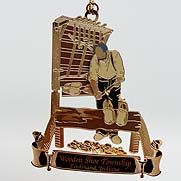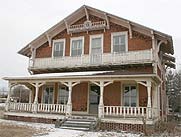2010 Essays: 2nd Place— The Ancestry of Dubois County A Population Predominantly German by Lauren Barth
In the early 1400s, the United States of America did not exist. Mother Nature and wilderness ruled the land, largely untouched by man. Dense forests blanketed the Midwest; however, all this changed abruptly when Christopher Columbus discovered the “New World”. Immigration to the apparently virgin land began immediately and has not ceased since. Each and every immigrant had a reason for leaving his homeland. Many wanted freedoms their mother country did not offer; some came against their will on slave ships; still others simply wanted the opportunity to live successful, fulfilled lives.
Many immigrants from Germany sought these opportunities in Dubois County, Indiana. Today numerous inhabitants of the county can trace their ancestors to specific towns and villages in Germany. Why did so many residents of Germany choose the remote, uninhabited area of Dubois County, Indiana as their destination for freedom?
Bad conditions in Germany caused many emigrations from the country. Starvation, illness, and harsh winters all contributed to citizens of Germany packing up their few possessions and leaving home (Lang 137). In 1816 and 1817 alone, crop failures caused 20,000 Germans to leave the country (Adams 4). Additional causes of emigration include high taxes and fear of war. In Germany, war meant mandatory military service and training (Lang 139) for many men, time farmers needed to plant, harvest, and care for crops. A letter from Germany in 1837 describes the condition in one German village: “Everybody is clamoring for money and food because what the troops did not eat, they destroyed. I also harvested very little and am making many debts which will be hard to pay” (140). A change in the Prussian church caused much immigration as well (142).
The Gehlhausens, one of many families, bravely left their homeland for a new country. They originally lived in Westphalia, Prussia (Johanneman 184-185), but chose to leave in 1836 when the new Kaiser forced his people to convert to his religion. The Kaiser sentenced to death any citizens who refused to follow his religion; therefore, the Gehlhausen family—rather than change their beliefs at the whim of the ruler—chose to begin a new life in America. The mother of the family, Maria Magdalena Schieck Gehlhausen, took her seven children, Theresia, Elizabeth, Frances, Wilhelm, Joseph, August, and Andrew, on the long journey across the Atlantic in hopes of finding a better life. (Busam 1, 3)
Johann Wolfgang Schreyer stated the following in 1846 in a letter from Indiana to relatives in Germany: “Independence is the greatest blessing of this country, and when one goes into the cities on the Fourth of July, one finds such festivities going on as excel all similar celebrations in Germany.” He continued to say, “It seems impossible to [a German] that there really is a country on earth where the worth of the individual is so recognized, and it is to him a delight to hear people say: ‘Thank God, I, too, am an American.’” (Lang 142) Upon hearing such news, citizens of Germany longed for similar freedoms and feelings of patriotism.
v Immigrants wished to have religious as well as political freedoms—never before did they have the chance to vote for a ruler or representative. Along with voting in America came a poll tax. A prospect that greatly appealed to Germans during wartime, this poll tax exempted men from required military service. The cheap fertile land greatly appealed to Germans as well. (Lang 140-142) In 1850, $150 could put a down payment on 40 acres of land (Adams 11). In addition the tax per acre of land in Indiana was only $0.01, and the owners did not have to pay property taxes for the first five years after the purchase of land (Lang 140).
When comparing the conditions in Germany to conditions in America, one can easily see why as many as seven million Germans came to America over three centuries; however, the exact number of German Americans in the United States remains unknown because of America’s melting pot culture. Willi P. Adams, a professor at the John F. Kennedy Institute, sums up the situation: “What the melting pot has put together, statistics can no longer untangle.” (Adams 3-4)
Statistics show that most German immigrants arrived between 1881 and 1890. The United States government actually promoted the immigration from Europe by issuing 10,000 copies of a document in 1870 containing facts about land, prices, products, and labor available in the United States. With the distribution of this document, whole villages decided to leave Germany for a second chance in America. Four thousand Germans left within two weeks, and the German government became concerned with the depopulation. Hoping that without the advertisements fewer Germans would emigrate, the government placed a ban on American documents. (Lang 132-137)
Once they arrived in America, the immigrants had to choose an area to settle. Adams states, “Like other immigrant groups, the Germans followed the natural instinct of forming neighborhoods with their countrymen where they felt at home far away from home.” When Germans crossed the Atlantic to America, they settled in areas with fellow Germans. The Germans actually had plans to emigrate from Germany to the United States and create a German state consisting entirely of citizens with German origins. For this reason, many villages stuck together and settled in the same region. (Adams 7)
Groups of Germans formed in the homeland in order to create and settle a German state in America. Consisting of hundreds, the groups planned to settle remote areas for farming. One group formed in Westphalia. The group left in the spring of 1834 from Bremen, Germany, and planned to settle in Arkansas and Texas; however, disagreements caused the group to separate while in the United States. Members broke away from the main party and settled in the area as those remaining in the group continued the journey. The remainder of the group eventually settled in St. Louis. (Lang 134)
The Gehlhausen family left port at Bremen as well, on a ship named the Alexander. They arrived in New York on June 4, 1836, possibly following the eldest brother of the family, John Phillip, who had arrived in New York by August 1834. (Busam 3, 6) John Phillip Gehlhausen may have traveled with the group from Westphalia as a scout for the rest of his family.
If immigrants desired unsettled farmland, they often chose to settle in the Midwest. From 1850 to 1920 the percentage of Germans in the Midwest was quite high: 35 to 39 percent (Adams 8). Many Germans settled in Louisville, Cincinnati, and Pittsburgh (Kleber 29). Because of the large number of Germans, Cincinnati was often called “Over the Rhine” (Lang 144). Numerous German Americans worked in Cincinnati to accumulate enough money to buy land in Indiana. These immigrants often traveled by boat on the Ohio River to Troy, Indiana, and from there they traveled north to the Jasper area. (Ferdinand 1)
The Gehlhausens followed a similar route. They traveled from Pittsburgh, Pennsylvania to Cincinnati, Ohio, and eventually to Troy, Indiana. A flatboat—made by the family—carried the Gehlhausens and their belongings down the Ohio River. Once they arrived at Troy, Maria and her family left the river and traveled by foot the 18 or so miles to Ferdinand, Indiana. The Gehlhausens carried all of their belongings. Weary after a difficult journey, the family may have been disappointed by the town. It simply consisted of a board nailed to a tree with “Ferdinand” burned into the board. (Busam 3-4)
Father Kundek, a Catholic missionary, founded Ferdinand on December 5, 1839 (Kleber 17), as a rest area between Troy and Jasper (Ferdinand 1). Albert Kleber, O.S.B., describes the scene: “It was into this valley and onto this slope that the lone missionary, [Father Kundek], projected his mental vision of a new Catholic town; he in spirit saw a large church resting serenely up on the ridge, its lofty tower as it were a mighty finger of God, pointing heavenward. . . .” (Kleber 16-17). The town, as the Gehlhausens found it, consisted of untouched land and forest. Albert Kleber sums up the situation, “Father Kundek now was the owner of a large tract of virgin land and had founded a town in a primeval forest, but there were neither houses nor citizens.” (Kleber 28)
Because his new town had no citizens, Father Kundek promoted immigration to Ferdinand in multiple ways. He advertised Ferdinand in a weekly publication Der Wahrheistfreund, a newspaper read by many Catholic Germans. Also, knowing many German Americans resided in Louisville, Cincinnati, and Pittsburgh, he preached in the areas to advertise as well. (Kleber 29) He also promoted Ferdinand in newspapers throughout Europe (Ferdinand 2) and distributed 520 copies of the Ferdinand land plats (Johanneman 4).
The plan worked. Adolf Brandeis illustrates the success of Father Kundek in a letter written to his wife in 1849 as he traveled through Ferdinand: “I am in a part of the country inhabited, for a distance of 60 to 80 miles, exclusively by Germans, and since I left the steamboat I have not heard a single word of English” (Lang 147). The following statistic demonstrates Father Kundek’s success as well: in 1870 Dubois County ranked third in the state for the county with the highest population of Germans (Lang 146).
The United States has appealed to millions of immigrants throughout the years. German families were especially drawn to Dubois County for various reasons. Today a vast majority of the citizens of the United States have ancestors from countries other than the United States. The story of the origins of the Gehlhausen family is only one of many similar stories of how and why so many Germans chose Dubois Country to begin anew.



